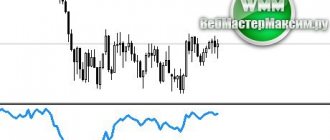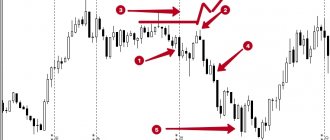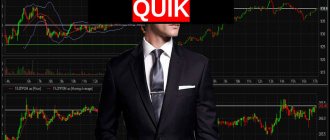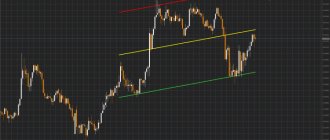The TEMA indicator is a specialized algorithm for assessing the current situation in the market. The algorithm in question was created on the basis of a time-tested tool called the “moving average”. The main goal of developing the TEMA indicator was to create an instrument whose signals, unlike moving averages, are more accurate due to the absence of lag.
The described algorithm is based on a unique formula that is used to carry out all the necessary calculations. You can see this formula in the next photo.
The TEMA indicator can be called truly unique, since it can be used with the same level of effectiveness on any currency pairs and time intervals.
To download the TEMA indicator, click on the link you can see below.
Channel indicator TMA
This indicator (Triangular Moving Average) is a mathematical representation of the calculation of moving averages and is displayed as a price channel. It consists of three lines: the central one is a simple moving average and two lines located on either side of the central one. Often the extreme lines are drawn as dots on the graph.
Triangular Moving Average – channel indicator
The indicator in its physical meaning resembles Bollinger Bands, but unlike them, it is built on the basis of not just moving averages, but on twice-smoothed moving averages. This makes the indicator less sensitive, but a trader can use it to more clearly track market movements.
Bollinger Bands
As you can see from the two figures, Bollinger Bands and Triangular Moving Average are similar, but Bollinger Bands react to every noise in the market, while TMAs are smoother with filters. But both indicators have advantages and disadvantages. And maybe someone will even try to combine them with each other when trading?
This indicator appeared relatively recently, so many terminals do not yet have it. It is worth noting that TMA is not used alone, but in combination with other technical tools: levels and lines of support and resistance, simple moving averages, oscillators (For example, the relative strength index (RSI) or MACD).
Trading signals! | Review of exclusive indicators from WBCCLUB
The vast majority of traders use one or another technical analysis indicator in their trading. Be it a simple moving average or a whole set that includes several oscillators and (or) trend indicators, giving the trader certain signals and telling him when to open, when to close a position, and when to refrain from entering the market altogether.
Such indicators as, for example: Moving Average (moving average), Stochastic, MACD, Volume, etc. They are described hundreds of times in numerous literature on technical analysis of the market, are presented in all popular trading terminals (MetaTrader, QUIK, etc.) and are completely free, and therefore very popular among a wide circle of traders and investors. />
Why signals from popular indicators are not accurate enough
It's no secret that the signals given by any indicator do not have sufficient accuracy to conduct even just break-even trading on them, not to mention trading that brings a stable profit. That is why, without exception, all authoritative authors strongly recommend that traders always look for confirming signals from other indicators or from other sources (price chart, fundamental factors, etc.). But despite the most sophisticated combinations and cunning settings, this kind of indicator strategies do not always result in a stable profit.
All this suggests that this state of affairs may be caused precisely by the availability, wide distribution and popularity of most indicators used by traders. Perhaps earlier, at the dawn of their appearance, they really gave their creators a certain advantage over the rest of the numerous “crowd” of market speculators, but having become widespread and entering the everyday life of every, excuse the expression, “dummies,” they have lost all their potential?
There is definitely some truth in this assumption. Well, judge for yourself, the market is far from a utopia like communism; here, a situation where the majority will win is a priori impossible. The mathematics here is quite prosaic; money does not come from anywhere, but is simply pumped from one pocket to another. Only a few earn money here, and they earn money precisely from the money that the majority loses. Therefore, the essence of truly successful strategies here is not to keep pace with everyone else, but, on the contrary, to outplay, to make a move contrary to the rest of the crowd of traders, speculators and other participants in all this fuss called the MARKET.
I in no way want to say that there are some “magic” indicators that can bring their lucky owners nothing but profit. All fabrications of this kind are just another attempt to find that same Grail. But in reality it always turns out that there is simply no such thing in trading.
Although if you look at this issue philosophically, the Grail can still be discovered, but it will not consist of a miracle indicator or the only correct strategy, but of the entire alloy that represents the work of truly successful professional traders. An alloy consisting of 90% psychology coupled with a streamlined trading strategy and a strict money management system. The remaining 10% is luck, well, where would trading be without it?
What could be the alternative?
There are no magic indicators, but there are definitely some that give a slightly higher (relative to most popular) percentage of the probability of the truth of the signals they provide. And, due to the above, such indicators should not be widespread among traders. It just so happens that the least common product is the one for which you need to pay a certain amount of money. Moreover, the point here is not so much in the amount, but in the very need to pay. Most people argue according to the principle: why pay money if there are a lot of free analogues.
Again, please don't misunderstand me. A paid product does not always mean the best. I am only talking about paid indicators solely in the context of the fact that they are not nearly as widespread as their free counterparts.
And for success in trading, as follows from the conclusions stated above, you need just such indicators that only a few use in their trading. In other words, they must either be created by you personally (in this case, complete exclusivity will be guaranteed to you), or purchased by you from someone else (usually not for free).
Exclusive indicators from White Bulls Crypto Club
I found the indicators presented by White Bulls Crypto Club on the popular Tradingview platform interesting. They interested me not only for their exclusivity (at the moment they are used by no more than 430 subscribers), but also for the fact that in addition to indicating the entry point, they also calculate the optimal levels for exiting a position. In other words, this tool can be used as a real trading system.
Of course, no one has canceled the rules of Money Management and you must enter a position with only a limited percentage of your deposit.
/>
Fragment of the WBCC-Club page on the Tradingview portal
In total, WBCCLUB offers ten different scripts for use:
- WBCC Main Scalp. An indicator for scalping designed to work on timeframes from five to fifteen minutes;
- WBCC Channel. An indicator created specifically for trading in channels (recommended time frame 15 minutes);
- WBCC trend tracker. Shows the direction of the trend but also works well in flat conditions (timeframe from 15 minutes to one hour);
- WBCC premium part 1. Countertrend indicator;
- WBCC premium part 2. Another counter-trend indicator;
- WBCC Level Strategy. Indicator for trading by levels;
- Test WBCC Level Strategy. A test version of the previous indicator, which can be obtained for three days completely free of charge;
- WBCC Scalp Strategy. Another scalping indicator for working on small timeframes (no more than 1 hour);
- WBCC Main Trend. Flagship indicator for working with the trend. Can be used on timeframes of one hour and higher;
- WBCC Strategy (1hour).
You can see their description for yourself on the official WBCCLUB page of the Tradingview portal: ru.tradingview.com/u/wbcc-club/#published-scripts, and just below we will look at the two main ones:
- WBCC Main Trend Indicator
- WBCC Main Scalp indicator
Lists of exchanges where WBCC indicators work:1) Cryptocurrencies:
2) Stock markets:
3) Forex:
By the way, here are the reviews people leave on the WBCC channel on Telegram (https://t.me/WBCCIndSig):
/>
WBCC Main Trend Indicator
This is what the work of their flagship, the WBCC Main Trend indicator, looks like on the chart:
The creators promise 80-90% correct signals and recommend working with it on time frames of 1 hour, 4 hours, 1 day and higher. At the same time, they guarantee its functionality with all exchange platforms presented on the Tradingview platform and offer to use it not only on FOREX, but also on the stock market and on the cryptocurrency market.
The indicator algorithm is constructed in such a way that, in addition to calculating the entry point into a position and sending the corresponding signal, it also determines the most optimal Take Profit and Stop Loss levels. So the trader can only duplicate all this in the trading terminal (open a position and place TP and SL orders).
A rather convenient feature is the ability to analyze the indicator’s performance over the past six months to determine which settings are suitable for each specific selected financial instrument (the percentage of high-quality runs with different sets of settings is analyzed and, as a result, those that give the largest number of correct signals are selected) .
The functionality of the indicator is quite wide and, in addition to its main functions, it supports the following features:
- Automatic drawing of trend lines for a specified number of candles;
- The ability to calculate the recommended Take Profit level, as well as analyze the dependence of the percentage of achieving a given Take Profit level on the indicator settings;
- The ability to calculate the optimal level of loss limitation (Stop Loss), as well as analyze the percentage of reaching this level depending on the indicator settings;
- Possibility of automatic construction of Gann angles;
- Possibility of entering a position using pending orders. When a new signal appears, levels for opening pending orders appear in the analytics window.
Here's what people write about it in reviews on Tradingview:
/>
WBCC Main Scalp indicator
This indicator is designed specifically for small time frames (5-15 minutes) and is intended for making intraday scalping transactions. There is no such expanded analytics window as in the option described above, but its functionality looks quite simple and intuitive.
/>
It draws clear signals to buy or sell (LONG or SHORT) on the price chart, and also displays recommended levels for taking profit (Take Profit). At the same time, the developers promise 80% correct signals.
You can enter a position either immediately on the market or with pending orders at the specified levels for buying (LONG) and selling (SHORT). You need to take profits at the levels indicated by black lines
/>
It can be used on the foreign exchange, stock markets, as well as on the cryptocurrency market. In other words, it is suitable for any exchange platform present on the Tradingview platform and allows you to work with any financial instrument presented there (with the appropriate set of settings, of course).
Here's what people write about it in reviews:
/>
Recommendations for use
Here's what indicator developers write about how best to use them in practice:
- A position on a signal should be opened only after its confirmation, namely, after the closing of the candle on which it appeared and the opening of a new candle (the signal should not disappear);
- You can combine the Main Scalp and Main Trend indicators with each other, namely, look for an entry using the Main Trend (time frame 4 hours) using Main Scalp (time frame 15 minutes);
- The Stop signal means that a price rollback is possible in the direction opposite to the original signal, i.e. red is a rollback to shorts, green is a rollback to long (they do not cancel the main LONG and SHORT signals, they simply warn you that it would be a good idea to transfer stops at breakeven, closer to the Stop signal or partially take profit).
If you are interested in the indicators described above, here are a couple more links for you:
- https://wbcc-club.com/ is the official website of the creators of the White Bulls Crypto Club indicators
- https://t.me/wbcc_chat – and this is their chat on Telegram
What does the Triangular Moving Average show?
Many traders use this indicator and highlight its following benefits in practice:
- The simple moving average (SMA) indicates the direction and strength of the underlying movement.
- The upper and lower lines are the visual boundaries of the channel indicator and represent dynamic levels.
- Some trading systems use the property of changing the direction of the channel by turning its lines, which corresponds to oversold or overbought assets.
The last property can be used to find reversal points of global trends. For example, when the price crosses the upper level, you should wait for a rollback and go down. Conversely, when the price crosses the lower limit, you should prepare to buy.
Working with the TMA indicator
But, like any other indicator, alone it is not capable of providing stable and effective signals in large quantities. Therefore, unsuccessful positions should be filtered using other technical means in combination with TMA.
How does the DeMarker indicator work?
The indicator itself has the character of an oscillator consisting of one line. The range it denotes is from 0 to 1 - the limit values are assumed to be 0.3 and 0.7. If the value of the DeMarker indicator reaches 0.3, we are talking about selling the market, and after breaking through 0.7, we are talking about the market being overbought. For investors, these are signals to open long and short positions.
As mentioned earlier, the DeMarker Oscillator works by comparing two periods - the moment when the market peaked with the period when it peaked earlier. If the current maximum is greater, the difference between them is calculated, and if the previous maximum is greater, then the value is zero.
Combination of TMA and RSI
The RSI indicator is one of the favorite oscillators among traders. It is convenient because it shows moments of oversold and overbought in the market and, in combination with other indicators, can indicate a reversal of the current trend.
The combination of TMA with the RSI oscillator allows you to track the current market trend and try to trade in the direction of the main movement, or track overbought and oversold zones and trade on reversals. The strategy shows high efficiency in trading both stocks and currencies on Forex, and when trading binary options.
A combination of two indicators – RSI and TMA
With this combination, there are 4 main trading methods:
- The RSI working line moves above the simple moving average TMA - a signal for asset growth.
- The RSI working line moves below the simple moving average TMA - a signal to reduce the asset.
- The working line of the oscillator breaks through the upper TMA channel - the asset is in the overbought zone, we expect a decline.
- The working line of the oscillator breaks through the lower TMA channel - the asset is in the oversold zone, we expect an upward movement.
This strategy should be combined with support and resistance levels, the touch of which will confirm a further trend reversal.
As a filter, you can use another indicator, CCI, instead of the RSI indicator.
DEMA indicator. Optimization
Installing the algorithm is simple. Even if you are a beginner and have no experience using similar tools, this process should not cause you any significant difficulties. After launching the DEMA indicator, a window with its parameters will appear in front of you.
The DEMA indicator has only one parameter, which is called “PERIOD”. This parameter is responsible for the number of candles that the algorithm will use to make calculations.
Due to the fact that the DEMA indicator has only one parameter, the value of which can be changed, the process of its optimization does not cause any difficulties. Since setting up this algorithm is quite simple, it can be recommended to beginners as a more advanced alternative to the time-tested moving average tool.
Useful tips on using and applying the indicator
Try to set the settings so that the extreme lines of the channel cover the latest highs and lows of the price. Fresh data will allow trading to be adjusted. The time range should be chosen based on the nature of trading and the preferences of the trader.
- If trading is based on transactions that are executed within a day, then you should ignore large single movements and concentrate on local highs and lows of a smaller price range.
- If you are trading in the long term, and the expiration time is a day or more, then using the settings you can adjust the boundaries of the TMA channel based on the last few major price movements.
It is worth paying attention to the important parameter ATRPeriod, which shows the number of periods (candles) by which the current value of the simple moving average and price channels are calculated.
EMA indicator what is it
EMA (Exponential Moving Average) is a type of moving average calculated exponentially. Compared to a simple or weighted average, the exponential gives much more importance to current values than to old values that occurred some time ago. In this case, it is assumed that information that enters the market today can cause greater price changes than referring to information already reflected in the chart earlier. For this reason, the old values gradually lose their importance over time until their weight becomes very insignificant.
EMA Formula
Moving averages are primarily based on closing prices.
To get rid of delays in moving averages, players usually choose EMA, because... The exponential reacts to changes faster than the SMA (simple moving average).
EMA indicator for MT4
To find ema in the MT4 terminal, click on Insert - Indicators section - Trend view - then Moving Average.
In the window that opens, set the MA method to Exponential, set the period in accordance with the strategy and goals, set the color on the side and click OK.
The exponential moving average will appear on the chart.
HMA Histogram indicator – modification of the classic version
The HMA Histogram indicator is an improved version of the standard Hull Moving Average.
This tool looks like a histogram and is very similar to the color modification of Macd. The histogram bars are colored in two colors – blue and red. The former give a signal for price movement along an upward trend, and the latter – for price movement along a downward trend. The indicator gives the main signal by changing the color of the histogram columns.
In addition, the height of the columns can be used to determine market volatility and movement intensity. For example, if you see a long red bar, then this indicates a strong downward movement. Conversely, if you see that the length of the red bars is consistently decreasing and the histogram is approaching the central (neutral) level, then this is a sign of a weakening downward trend and a decrease in volatility. Perhaps the trend will change soon. A change in the color of the bars indicates a change in trend, namely:
- If the red bars are replaced by blue ones, this means that the downward trend has changed to the opposite one.
- If the blue bars are replaced by red ones, this means that the upward trend has changed to a downward one.
HMA in the form of a histogram has exactly the same calculation principle and set of settings as the classic Hull Moving Average. All that distinguishes these indicators from each other is their external design and the way they send signals.
SupDem Algorithm Zones
The tool highlights the following supply and demand zones on the chart:
- Weak Zone. Weak areas that have not yet been tested and worked out. They should not be used as a guide when entering into transactions.
- Untested Zone. Marked but not yet tested areas. Trading with them is accompanied by great risks. It is not recommended to use them to open orders.
- Verified Zone. Checked areas. They can be used as a guide when trading. Give signals of moderate strength.
- Proven Zone. The strongest zones that have been repeatedly checked and tested by the indicator. They provide high-quality signals and are recommended for opening Buy, Sell, Buy-Stop, Sell-Stop, Stop-Loss and Take-Profit orders.
The indicator highlights each of these zones on the chart using empty or color-filled rectangles and horizontal lines.
The width of the allocated zone will depend on the price movement. The longer the price was in the specified area, the wider the zone will be. In the indicator settings, you can also deactivate the display of certain zones. For example, you can configure SupDem to show only strong and proven zones suitable for opening trades.
Calculation of the DeM index
The values calculated in this way are added together. Then we divide the result by the sum of the difference between the price minimums of the current and previous periods. However, it is worth knowing that in the case of minimum prices, a value of zero is assumed when the current minimum is greater than the previous one.
After calculating the maximum and minimum prices, you can proceed to the calculations of the DeMarker indicator. Will help with the pattern:
DeM = SMA (DeMax, N) (SMA (DeMax, N) + SMA (Demin, N)
Where:
SMA - simple moving average N - number of periods
Disadvantages of the DeMarker indicator
- Difficult setup, especially for beginners
- The parameter cannot be used independently
- The need to perform a large number of tests
Other Users Also Read:
Working on the Internet without investment attracts more and more people every year! And this is natural, since it has huge advantages over office work.
The most popular method of making money on the Internet in 2020-2021 is investment . Learn how to invest correctly for free, watch our VIDEO COURSE ABOUT INVESTMENTS ON THE INTERNET (FREE)
The content of the article is the opinion of the author and not the official position of blog-slona.com. The material published on this website is for information purposes only and should not be construed as investment advice within the meaning of Directive 2004/39/EC.
TagsDeMDeMarkerTechnical analysis indicatorsTechnical analysisTradingForex











